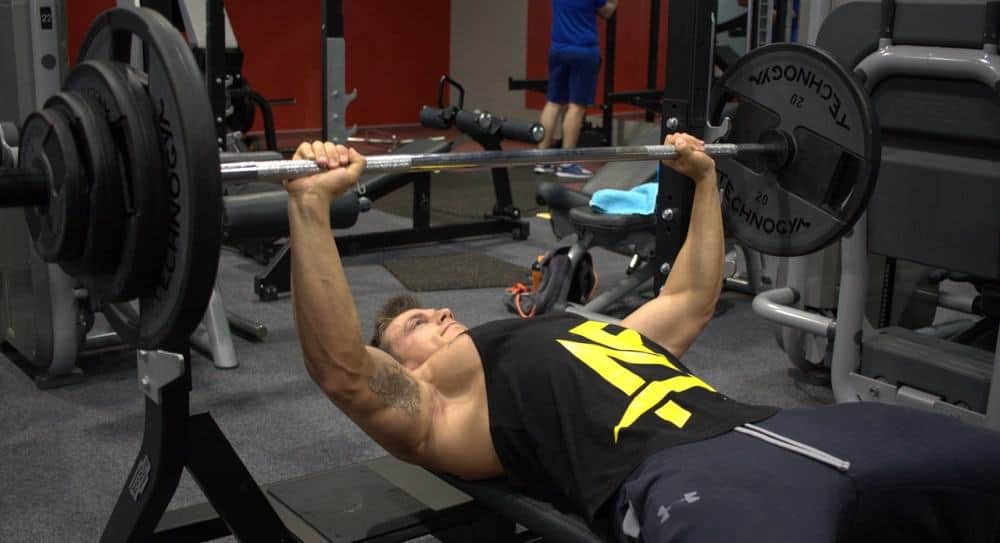
For muscle and strength building it is necessary to make progress over time and thus, increase training intensity and volume continuously.
However, it should be clear to everyone that progression cannot be linear and that in an advanced stage of each and everyone’s training career improvements become smaller and smaller and require tremendous effort.
For this reason, regular training breaks, so-called Deloads are necessary to maintain continuous progress.
All that said, in today’s article I am going to talk about Deloads. What actually is a Deload? How does a Deload Work? Are there different ways of how to conduct a Deload?
This and a lot more will be covered in the following article.
So first and foremost, what precisely is a Deload?
To put it in a nutshell, a Deload basically is a light training period to reduce accumulated fatigue.
As you have learned before, you add a bit of fatigue with each workout. To that
At some point, you will get into a state of overreaching and later, if the load is not reduced appropriately, even in overtraining.
However, if fatigue can be completely recovered between training sessions with a longer break, there is no need for a deload.
Having said that, why actually is a deload a necessity?
Accumulating fatigue keeps your current performance low. Without a Deload from time to time, it is impossible to properly enhance performance which eventually, leads to stagnation because progression stays out.
In reality, of course, we always have a certain level of “basic exhaustion“, for example, because we are constantly exposed to gravity which means that our fatigue level never falls down to zero.
The word “fatigue reduction” is thus rather the complete degradation of fatigue which is caused by steady training.
With this in mind, you hopefully noticed by now that a Deload is a necessary factor if you really want to train hard and achieve optimal muscle growth.

How to Deload Guide
Deloads can be tackled in a variety of ways. It is always important that the previously accumulated exhaustion is fully depleted. If you feel extremely exhausted after a deload workout or you even have sore muscles, there is definitely something going wrong.
Deloads are meant to achieve the exact opposite, to recover your whole body in order to become even stronger.
Deload for beginners
As described in a separate article, overreaching is not necessary for beginners to get the best results.
Since beginners have difficulties to properly overload their system, they will not be able to easily get into a state of overreaching.
Nonetheless, I don’t want to say that it’s not possible, that certainly is. However, those who follow a reasonably good training approach, who are not permanently in a strong caloric deficit or on the brink of burnout will usually not get there.
How and when should a beginner deload?
A beginner reduces the weight by 10% once stagnation occurs.
Based on this new weight (– 10%), the linear progression, ie the intensification from training session to training session, should continue as normal. This is particularly what represents a beginner:
Beginners can improve performance from unit to unit, either with more weight or more repetitions.
Let’s take a look at an example to make it more clear.
| 50,0kg 5x5x5 | increase | 52,5kg 5x5x3 | increase | 52,5kg 5x5x4 | increase |
| 52,5kg 5x5x4 (stagnation) | reduce | 47,25kg 5x5x5 (10% Deload) | increase | 50,0kg 5x5x5 | increase |
| 52,5kg 5x5x5 (peak performance) | increase | 55,0kg 5x5x4 | increase | 55,0kg 5x5x5 | increase |
As you noticed, this is not an explicit Deload week. For beginners, the 10% reduction in weight composes the deload.
This means, not to reduce your actual “working weight” by 10% for one whole week and then going back to your old values. Rather, and ideally, you’ll have new “working weights” after the deload which will first meet your previously used weights x 0.9.
As already explained, from there you will again run a linear progression, using (as usual) the smallest possible weight increase from unit to unit. By reducing, you will be able to achieve better long-term results and be more likely to overcome
Even though this may sound counterintuitive to you at first, you can use this targeted weight reduction to increase your training effect, as you push some training parameters (volume, load, etc.) in the direction of optimum. However and most importantly, this concept only applies if you truly overreached before.
But what happens if you stagnate in the same place after Deload?
The following options would be possible:
- You are no longer a beginner -> Set a new goal for your progression and change your approach
- The reason for the stagnation was too little volume -> Perform the deload and increase your volume
- Your diet, recovery or your stress level lack optimization -> Try to get these factors aligned appropriately
If you still feel strong symptoms of overreaching, a full deload week would be appropriate, which is described in more detail in the next section.
Deload for advanced athletes & professionals
For advanced athletes and professionals, a 10 % weight reduction is oftentimes not enough to recover fatigue efficiently. In that case, it would be advisable to reduce the volume by 50% for one week.
As you already know, the volume is calculated as follows:
Volume = Weights x Sets x Reps
With this in mind, we can reduce either the weight or the total number of repetitions by 50%. It doesn’t necessarily have to be a 50% reduction, any other combination is possible that ultimately reduces the volume by about 50%.
Like everything in life, everything has its advantages and disadvantages.
Let’s take a closer look at two possible extremes:
a.) Reduction: weight = 50% | Total repetitions = 0%
With that approach, you’ll have the greatest regeneration of the tendons, ligaments, and joints (passive structures), as peak loads are significantly reduced. Anyhow, the disadvantage that comes by is a difficult re-entry into your “normal” training, because during the deload week you weaned your body off from heavy weights.
This is an approach especially suited for someone who finds bigger problems with his passive structures but has no problems returning into the old training routine at the end of a mesocycle.
However, if you quickly wean yourself off and joint pain is a foreign concept to you, perhaps another approach would be more appropriate.
b.) Reduction: Weight = 0% | Total repetitions = 50%
In contrast, the re-entry is obviously easier, since you keep using the exact same weights. However, the peak loads on the joints and Co. are not significantly reduced (due to the heavy weight) which leaves us with a lack of regeneration for the passive structures.
Especially for athletes with re-entry problems or no overloading of the passive structures, this kind of deload offers a great match.
In any case, you should also reduce the load, that is, done by cutting off a few repetitions per set, so that you stay away from muscle failure.
As mentioned above, other combinations of reductions are also viable in a deload.
The tendency is to say:
The lower the weight, the greater the weaning and the better the regeneration of the passive musculoskeletal system (tendons, ligaments, and joints). However, this can make it much harder to reenter into “normal” training.
So you have to ponder very profoundly which position of the scale you want to stand and what is likely to suit your current goals and condition the best.
Of course, with a volume reduction of 50%, you always have a strong relief of the passive structures because a high volume always means a high load on your system.
By now, you have learned what a real deload should look like and under what criteria you should change the training parameters.

Deloads – Reactive vs. Planned
Deloads can be performed in two ways:
Planned after “X” weeks
This approach is pretty logical and easy to understand. Basically, always after a certain time, a deload is carried out, no matter whether symptoms occur or not.
The risk that comes to play here, is conducting a deload without really having trained hard enough before. In other words, without even needing a deload at all.
As a result, you waste a lot of potential and time, and in the worst case not make any progress.
Or the opposite is the case:
If someone suddenly sleeps less or is exposed to higher levels of stress, they will overreach faster and need a deload sooner than planned. So the biggest problem here is estimating the deload requirement.
Reactive after symptoms have occurred
In this variant, unlike the first approach, one waits for symptoms of overreaching to occur.
The big problem here can be the self-assessment since many signs of fatigue occur creeping and may not be recognized in time. Regardless, symptoms in joint structures often appear almost too late. Paired with an “I’m indestructible mentality”, it may be already too late for one or the other and eventually the risk of injury scales up.
Since both variants are not fully satisfactory, I recommend you to do both. It is best to set a certain time frame (for example, 4-8 weeks) in which you determine to perform a deload. When that deload is going to happen, is decided respectively of the symptoms.
If you have a very regular life, the first variant would be recommended. In that case, you can then adjust your training so that the symptoms precisely occur after “X” weeks.
Deloads – Global vs. local
But what if some muscle groups overreach faster than others?
In other words, experiencing overreaching symptoms rather locally and globally.
In that case, it is totally feasible to solely recover the affected muscle group with a break (Deload) and continue exercising the remaining muscle groups as normal.
For example, if your knees feel overloaded, progression in squats stay out but at the same time making great progress in
The advantage here is obvious: you waste no time with too light training.
However, if you are looking for maximum muscle gains, you should try to overreach all muscle groups at the same time.
There are two cases where a local deload can make sense:
Great regeneration differences
Due to your genetics, current training or previous training history, some joints, tendons, ligaments, or muscles may tolerate more exercise than others.
As a result, these areas naturally overreach faster than others which is why it may make sense not to perform the deload holistically.
Strong volume differences
Suppose you want a big chest like all those superheroes but not interested in trained legs because you cannot see them in the club. In that case, you would spend a lot of volume on your chest and very little on your legs at the same time.
Now, you have three guesses if you’re likely to faster get into a state of overreaching in your chest or legs. It is even possible that you might never need a leg-deload because you always completely reduce the fatigue due to the small volume.
Deloads – Duration
The duration of a deload highly depends on the accumulated fatigue. In general, I would recommend a time span of roughly a week, that is 7 days in a “normal state of Overreaching”.
As a reminder: for beginners, the Deload is a weight reduction by 10%, so no additional phase with greatly reduced volume.
But what if you already feel good before the end of the deload and assume being able to work out?
Should you then abbreviate your deload?
In general, you should not cancel your deload for the following reasons:
1.) Passive structures
Tendons, ligaments, and joints sometimes need more time to regenerate properly. So while your muscles are already back on track with full capacity, your passive structures have to start with a pre-exhaustion into the new training cycle.
Even worse, this pre-exhaustion adds up each time a new training cycle as it has never been completely depleted, and accordingly, the joint load continues to increase.
2.) Volume tolerance
While the power may be back after a few days, the ability to deal with a lot of volume takes longer (in most cases).
In other words: even if you can perform well in the first few sets or even training sessions, you will probably not be able to cope with as much volume over a period of several weeks as you would ideally be able to do.
In view of the fact that volume is probably the most important factor for muscle growth, premature deload break makes little to no sense at all.
A Deload is not only needed for performance recovery, but also for the best possible preparation for the upcoming training mesocycle (through maximum volume tolerance).
Simply because you feel fit as a fiddle again, it does not necessarily mean that your passive musculoskeletal system was able to fully recover or that your volume tolerance (for the next training mesocycle) is at its peak.
Ultimately, the specific rate of regeneration of the individual components (muscles, joints, etc.) of our body and also the time to get back to optimal performance depends on many factors. Some of these would be, for example, genetics, general stress levels, nutrition, and above all the extent of overreaching.
Thus, it can be said that certain parts of the body can regenerate faster than others.
Finally, it is important to understand that all these deload considerations only make sense if you truly overreached and consequently there is a need for a deload.
Take home
To conclude, no matter how many advantages deload training has, it is not suitable for everyone!
Beginners, for example, are still miles away from resorting to such tricks. Usually, they do not have to, because as a beginner it is way tougher to get into a state of overreaching as your body makes progress really fast.
However, the more advanced you are and the longer you train, the harder it will be to further build muscle and the sooner your body needs a deload week.
Nonetheless, even if you have been training for years, if your intensity is low and you may train “only” twice a week, you do not have to implement a deload.
Everything else is then trial and error – as I said, each of you individually responds to stress. So there is no “magic formula” but you can use the guidelines and benchmarks from this article to orientate yourself.
Let’s recap some key notes from today’ article about what a deload actually is and how it does work:
- A Deload is a light training period, in which volume is usually reduced by 50% so that the accumulated fatigue can be reduced.
- The duration of the period depends on the amount of fatigue but usually lasts 7 days
- Whether a weight or set reduction makes more sense, everyone must decide individually for themselves
- You should first set the time period of a deload roughly (between 4-8 weeks) and then reactively deload within this time frame if needed
- If symptoms are only locally noticeable, it is viable to solely recover the affected muscle groups and keep exercising the maintaining muscle groups as usual
- A deload is absolutely necessary when training is
hard , but superfluous in light or less frequent training.
Now it’s your turn: Do you frequently implement deloads into your training? How do you assess whether you need a deload or not?
Leave a comment below and contribute to the discussion!
Thank you so much for your attention and the read,
Claas





6 thoughts on “What are Deloads and How do They Work? Complete Guide 2019”
Pingback: The Benefits of Doing Deloads - This is Why You Should Take Deloads! - Emerging Athlete
Pingback: The Optimal Abs Volume - Hypertrophy Guide - Emerging Athlete
Pingback: Optimal Volume for Hypertrophy - Full Guide 2019 (Backed by Science)
Pingback: The Optimal Traps Volume - Hypertrophy Guide - Emerging Athlete
Pingback: The Optimal Glutes Volume - Hypertrophy Guide - Emerging Athlete
Pingback: The Optimal Back Volume - Hypertrophy Guide - Emerging Athlete